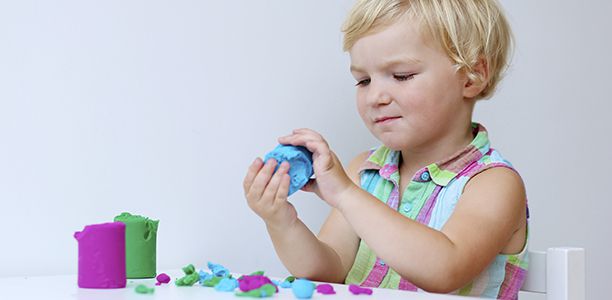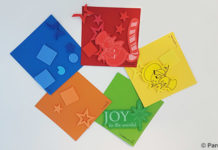As babies develop the gross motor skills that enable them to toddle around, they are also improving their fine motor skills which allow them to pick objects up and manipulate them. If you’ve got a toddler you’ve almost certainly noticed that they’re interested in touching just about everything they can get their hands on! They’ll probably also reach out and try to grab for things which they can see but are out of reach.
Their fine motor skills will develop rapidly in the next eighteen months and there are plenty of fun ways you can help them develop their finger muscles. Playing games that involve placing small objects in and dumping them out of containers is fun at this age and a great way to help them develop their fine finger muscles. They’ll also be beginning to coordinate the use of both their hands at once, so activities that require the coordination of both hands like clapping games, threading beads and washing hands can help. Writing is an important fine motor skill which toddlers will benefit from every opportunity to practice.
Toddlers 18-24 months
From about 18 months of age your child may begin to demonstrate the ability to:
- Hold a pencil or crayon in a fist grip (radial cross palmar grasp and palmar supinate grasp) and use it to scribble or make marks on a piece of paper.
- Use pincer grasp (the thumb and forefinger only) to pick up small things, for example small pieces of food like cereal or cut vegetables.
- Pick up small objects, place them in a container and dump them out again.
- Poke, push or pinch parts of a toy with one hand, while holding it with the other.
- Feed themselves efficiently using their fingers.
- Use utensils like baby spoons and forks for feeding, scoop food and bring it to the mouth- but expect them to get some food on their face.
Toddlers 24-30 months
Between 24-30 months toddlers continue to improve their fine motor abilities and become increasingly independent feeders and improve their ability to write, draw and manipulate objects and tools. At 2-2.5 years, your child may:
 Begin to show a preference for one hand or the other (just over half of toddlers show preference for being left or right handed at this age).
Begin to show a preference for one hand or the other (just over half of toddlers show preference for being left or right handed at this age).- Jab at the paper and make scribbles by moving their entire arm while holding the pencil in their fist. Their thumb may be either up (palmar supinate grasp) or down (radial cross palmar grasp).
- Start turning the pages of a board book one at a time instead of two or three at a time.
- Make shapes from play dough by rolling, squeezing and pounding it.
- Snip at the edges of paper, probably holding the scissors and paper incorrectly. For example, they will hold the paper at the wrong angle and may try to use two hands to use the scissors.
- Enjoy putting big dollops of glue on the page but be unable to coordinate their hands to spread it.
Toddlers 30-36 months
As they approach their third birthday children become more competent at writing and feeding themselves and start to perform self care tasks like doing up their own buttons, independently. At this age most children:
-

Digital pronate grasp Begin holding pencils, crayons and other writing implements in their fingers instead of their fist. The pencil is gripped in the fingers with the end resting in their palm. The palm faces downwards. This is the second stage writing grasp, also referred to as digital pronate grasp. However, they have still not developed the proper pencil grip (known as tripod grasp and characterised by holding the pencil between thumb and forefinger) and continue to use their entire hand. Although their entire hand is involved in moving the pencil, children rely more on their thumb and forefinger. They rest the side of their hand on the little finger on the paper, but still hold their wrist and forearm up off the paper or desk. At this age most children like to scribble circles and lines on their paper.
-

Dynamic tripod grasp Can make stacks from blocks and connect interlocking construction blocks;
- Thread a large bead or piece of coloured pasta onto a shoelace.
- Play with a peg board that uses large pegs.
- Manipulate the pieces to do simple jigsaw puzzles. Puzzles which involved fitting shapes like squares and circle into the write hole or fitting together a small number of pieces (e.g. a four piece jigsaw puzzle) are appropriate at this age.
- Feed themselves using utensils like a spoon. They should also be able to drink independently from a cup. By their third birthday most children should be able to hold the cup in one hand.
- Help dress themselves, however they are still too young to dress independently and require adult help. They may be able to unfasten large buttons or put on outer clothing like their jacket unassisted. They will probably also be able to fasten and unfasten large zippers.
- Wash their hands with an adult’s help.
- Turn a door know to open a door.
Free download
 |
Download a checklist of developmental milestones for toddlers. |
You might also like…
 |
To read more about fine motor skills and development in other age groups, visit Fine Motor Skills. |
References
- Virginia Early Childhood Development Alignment Program. Milestones of child development- A guide to young children’s learning and development from birth to kindergarten. 2009. (cited 12 May 2014). Available from: (URL Link)
- South Carolina Education Office of Early Childhood Education. South Carolina Infant and Toddler Guidelines. 2010. (cited 12 May 2014). Available from: (URL Link)
- Calder Help your preschool child develop fine motor skills. 2006. (cited 12 May 2014). Available from: (URL Link)
- Community Childcare Cooperative Ltd (NSW). Development Milestones and the Early Years Learning Framework and the National Quality Standards. Australian Government Department of Education, Employment and Workplace Relations. 2012. (cited 5 May 2014). Available from: (URL Link)
- Andrews General Categories of Fine Motor Development. Michigan State University Extension. UNDATED. (cited 28 March 2014). Available from: (URL Link)
- Owens Supporting children’s development- fine motor skills. Putting Children First. Issue 28. 2008. National Childcare Accreditation Council. (Full Text)
- Achorn LB, Wait KJ. The Relationship between Fine Motor Skills and Fluency of Handwriting in Kindergarten and First Grade Children. Paper presented to the Sage Colleges Program in Occupational Therapy. 2005. (cited 4 September 2014). Available from: (URL Link)
- Columbia Developmental Progression of the Grasp. Undated. (cited 4 September 2014). Available from: (URL Link)
- Eastern Kentucky University- Occupational Therapy. Writing Grasps. 2011. (cited 4 September 2014). Available from: (URL Link)



 (6 votes, average: 4.33 out of 5)
(6 votes, average: 4.33 out of 5) 









